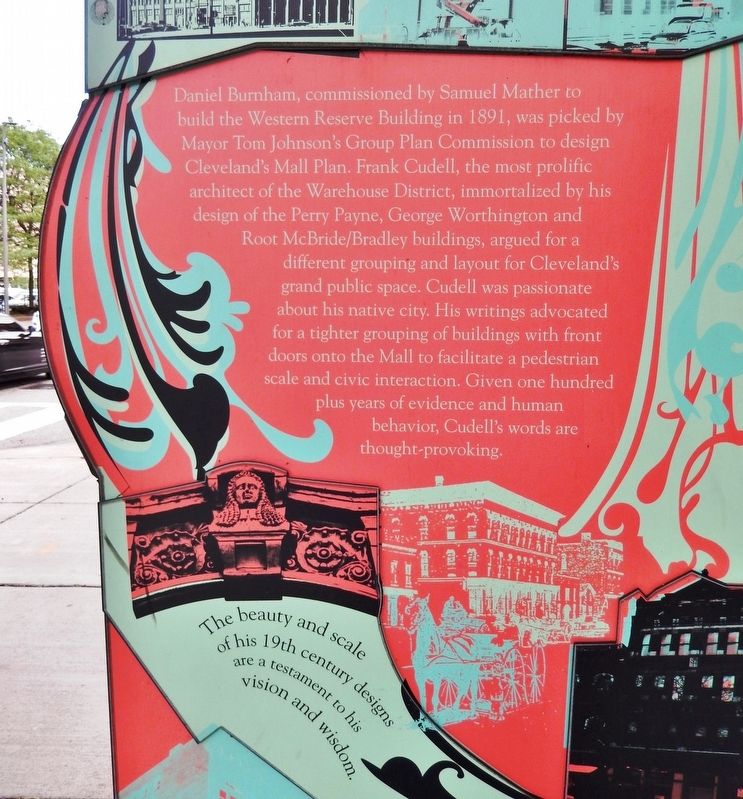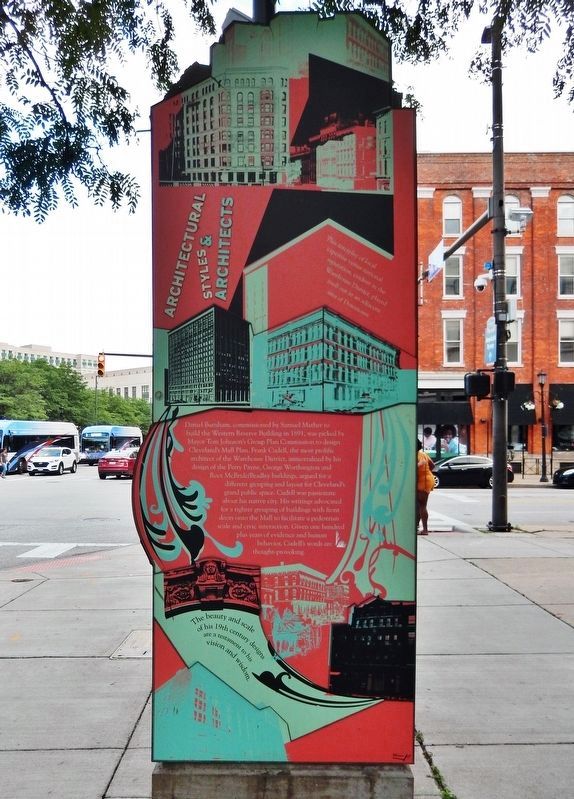Downtown in Cleveland in Cuyahoga County, Ohio — The American Midwest (Great Lakes)
Architectural Styles & Architects
Warehouse District Anthology
The interplay of local expertise versus national reputation, evident in the Warehouse District, played itself out in an adjacent area of Downtown.
Daniel Burnham, commissioned by Samuel Mather to build the Western Reserve Building in 1891, was picked by Mayor Tom Johnson's Group Plan Commission to design Cleveland's Mall Plan. Frank Cudell, the most prolific architect of the Warehouse District, immortalized by his design of the Perry Payne, George Worthington and Root McBride/Bradley buildings, argued for a different grouping and layout for Cleveland's grand public space. Cudell was passionate about his native city. His writings advocated for a tighter grouping of buildings with front doors onto the Mall to facilitate a pedestrian scale and civic interaction. Given one hundred plus years of evidence and human behavior, Cudell's words are thought-provoking. The beauty and scale of his 19th century designs are a testament to his vision and wisdom.
Erected by The Warehouse District Development Corporation.
Topics. This historical marker is listed in this topic list: Architecture.
Location. 41° 29.984′ N, 81° 41.927′ W. Marker is in Cleveland, Ohio, in Cuyahoga County. It is in Downtown. Marker is on West 6th Street just north of West Saint Clair Avenue, on the left when traveling north. Touch for map. Marker is at or near this postal address: 700 West Saint Clair Avenue, Cleveland OH 44113, United States of America. Touch for directions.
Other nearby markers. At least 8 other markers are within walking distance of this marker. The Warehouse District (here, next to this marker); Liberty Enlightening the World (within shouting distance of this marker); Independent Clothing Stores (about 500 feet away, measured in a direct line); The Garment Industry (about 500 feet away); Hardware Industry (about 600 feet away); William Bingham (about 600 feet away); This Marks the Site of the Weddell House (about 700 feet away); Rockefeller Building (approx. 0.2 miles away). Touch for a list and map of all markers in Cleveland.
More about this marker. Warehouse District Anthology is a collection of stories that tell the history of Cleveland's first neighborhood. Like street level book pages, each freestanding element was designed by artist Corrie Slawson based on the District's history, curated and written by Thomas Yablonsky.
Related markers. Click here for a list of markers that are related to this marker. Cleveland Warehouse District Anthology
Also see . . .
1. Daniel Hudson Burnham.
A successful Chicago architect, he was selected as Director of Works for the 1892–93 World's Columbian Exposition, colloquially referred to as "The White City". He had prominent roles in the creation of master plans for the development of a number of cities, including the Plan of Chicago, and plans for Manila, Baguio and downtown Washington, D.C. He also designed several famous buildings, including a number of notable skyscrapers in Chicago, the Flatiron Building of triangular shape in New York City, Union Station in Washington D.C., London's Selfridges department store, and San Francisco's Merchants Exchange.(Submitted on February 23, 2022, by Cosmos Mariner of Cape Canaveral, Florida.)
2. The Cleveland Mall.
The Mall was conceived as part of the 1903 Group Plan by Daniel Burnham, John Carrère, and Arnold Brunner as a vast public space flanked by the city's major civic and governmental buildings, all built in the neoclassical style. In the spirit of the City Beautiful movement, formerly seedy areas were transformed into a "magnificent civic center." Even though the plan was never fully carried out, it was one of the few City Beautiful plans to be realized to a large extent and remains one of the most complete examples in the country.(Submitted on February 23, 2022, by Cosmos Mariner of Cape Canaveral, Florida.)
3. Frank E. Cudell.
He formed a partnership with John N. Richardson in 1870. Cudell & Richardson designed commercial buildings embodying lighter structure, more open walls, and the use of cast and wrought iron, demonstrated in the Geo. Worthington Bldg. (1882), the Root & McBride-Bradley Bldg. (1884-85), and the Perry-Payne Bldg. (1889) — the first building in Cleveland to use iron columns, not a steel frame, throughout all 8 stories, and celebrated for its interior light court. Cudell was interested in the Group Plan, pointing out flaws in the Group Plan Commission's plans.(Submitted on February 23, 2022, by Cosmos Mariner of Cape Canaveral, Florida.)
Credits. This page was last revised on February 4, 2023. It was originally submitted on February 22, 2022, by Cosmos Mariner of Cape Canaveral, Florida. This page has been viewed 115 times since then and 13 times this year. Photos: 1, 2. submitted on February 23, 2022, by Cosmos Mariner of Cape Canaveral, Florida.

